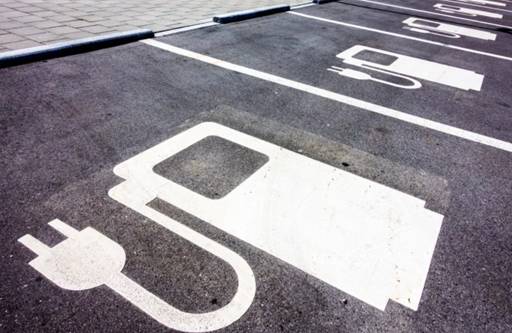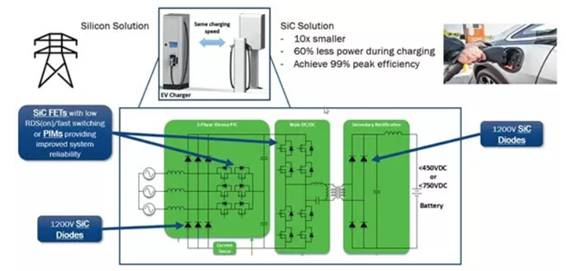
Silicon carbide devices: the best choice for three-stage charging piles for pure electric vehicles
“How long does it take to fully charge a pure electric vehicle (EV)? If you use household AC power, I’m afraid it will take you all night. In order to solve the problem of charging time, a three-level “fast” DC charging technology came into being, which is expected to reduce the charging time from several hours to several minutes. In this article, we will explore the relationship between conversion efficiency and high-speed power conversion, and reveal the reasons why the new wide band gap technology is very suitable for this type of work.
“

How long does it take to fully charge a pure electric vehicle (EV)? If you use household AC power, I’m afraid it will take you all night. In order to solve the problem of charging time, a three-level “fast” DC charging technology came into being, which is expected to reduce the charging time from several hours to several minutes. In this article, we will explore the relationship between conversion efficiency and high-speed power conversion, and reveal the reasons why the new wide band gap technology is very suitable for this type of work.
Charging time is as important as mileage
Pure electric vehicles are becoming more and more popular, and as potential users learn more about them, pure electric vehicles are very likely to usher in a faster development. According to the US Energy Information Administration (EIA) forecast, from 2018 to 2050, pure electric passenger vehicles with a cruising range of 160.9km, 321.8km and 482.8km will achieve a 29% increase. Thanks to the bills and incentives promulgated by the US federal and state to stimulate demand for pure electric vehicles, more consumers are now willing to list pure electric vehicles as candidates when buying new cars. Regardless of whether the consumer’s move is motivated by the “political correctness” of “protecting the global environment” or a serious decision made after a detailed and wise investigation, the mileage will certainly be a topic that cannot be avoided in the selection process, and some thoughts are even more important. In-depth consumers may further consider the time required to fully charge. In the eyes of most car owners, charging a pure electric vehicle is like refueling a petrol vehicle. The latter obviously takes no more than 10 to 15 minutes; however, for pure electric vehicles, the reality is very skinny: most pure electric vehicles All adopt the on-board AC charging scheme, and it takes a whole night or at least several hours to fully charge (Table 1). At present, most of the pure electric vehicle charging piles deployed across the United States are primary charging piles (usually household AC power) or secondary charging piles (parking lots and retail locations connected to three-phase AC power). The above-mentioned charging level is defined by the Society of Automotive Engineers (SAE), the association’s J1772 standard specifies the plug and socket layout of the primary and secondary charging piles. For secondary and tertiary charging piles, SAE specifies a combined plug and socket standard.

Table 1: Types of charging piles for pure electric vehicles, listing various charging levels and corresponding charging time and power requirements (Source: ON semiconductor)
As shown in Table 1, if a pure electric vehicle wants to unlock the “quick blood recovery” skill like a fuel vehicle, it must rely on a four-stage charging pile and a vehicle that supports DC charging. Realizing four-level charging requires extremely high power, and its design focus is no longer on-vehicle AC-DC charging piles, but high-power, high-efficiency DC charging piles. Nowadays, although the four-level charging pile is technically feasible, it has extremely high requirements on the local power grid. Therefore, considering the balance of charging time, cost, and grid carrying capacity, the three-level charging pile has become a kind of quite Promising solution.
Design of fast and high-power three-stage charging pile
The three-stage charging pile is also called “fast charging” charging pile, which can provide a maximum current of 500A. It needs to adopt a high-efficiency three-phase power conversion topology. This topology usually uses a power factor correction (PFC) with a DC-DC converter based on a Vienna rectifier. ) Method (Figure 1). This AC-DC conversion method makes full use of the three different levels of the three-phase power supply in the grid, and can achieve the required output power with high efficiency, high density, and low material consumption.

Figure 1: Three-stage charging pile for pure electric vehicles using Vienna PFC converter topology (Source: ON Semiconductor)
Adopting the Vienna topology has many advantages, but it also brings no small challenges, because the use of this topology requires high-power and high-frequency conversion switching operations, which will also generate switching losses, and the heat generated by the conversion losses also needs to be dealt with. . These challenges and the space limitations imposed by the location of charging equipment have driven power supply design engineers to continuously seek semiconductor process technologies that surpass the characteristics of today’s silicon-based diodes and MOSFETs.
The Links: LM057QC1T01R NL10276BC3018



